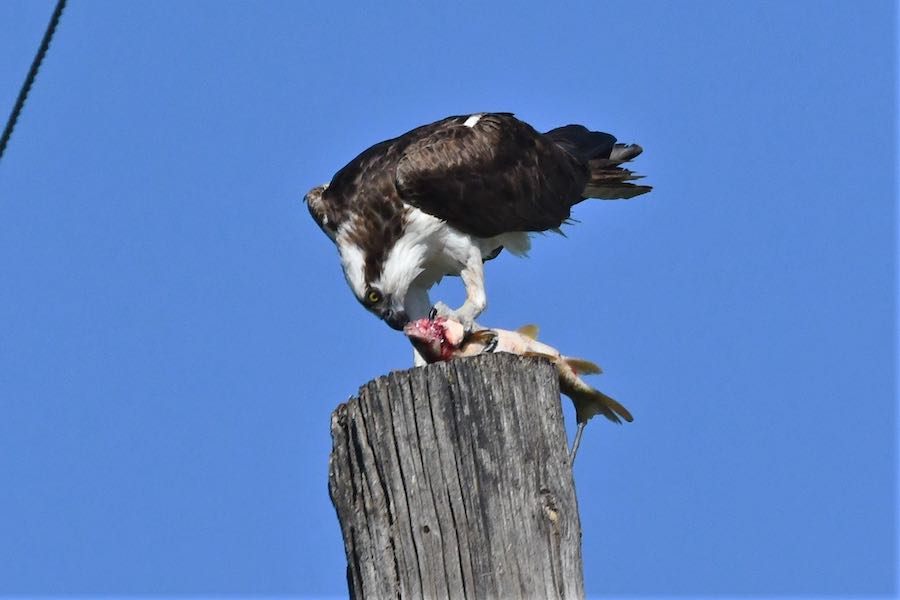 A female Osprey with two chicks in a nest near Market Lake, waiting for Dad to come home with breakfast. Bill Schiess, EastIdahoNews.com
A female Osprey with two chicks in a nest near Market Lake, waiting for Dad to come home with breakfast. Bill Schiess, EastIdahoNews.com
“I wonder where in the world he went to get breakfast,” I thought I heard the mom say to the kids as she kept calling from her perch. “He probably got lost or got distracted; I wish he would answer me, we are getting hungry.”
I, too, was getting impatient. I had been waiting for over an hour for the male osprey to bring home breakfast as I watched the female keep the kids from the edge of the nest. She finally started calling a little louder and moved the two kids to the side of the nest, indicating that she had located him coming in. My wait was over as I watched him land on a nearby power pole, with a nice Utah chub in his talons.
The family’s wait was not over; he had to prepare the meal for them. He did that by starting to eat the head of the fish while the female impatiently called to him to hurry up. It took him about 12 minutes to consume the head of the fish, relishing as he ate the choice delicacy – the brain.
 The male Osprey returns to the nest with a nice Utah chub, but eats the head before taking it to the nest. | Bill Schiess, EastIdahoNews.com
The male Osprey returns to the nest with a nice Utah chub, but eats the head before taking it to the nest. | Bill Schiess, EastIdahoNews.com As he finished eating his portion, he straightened up as Mom moved the kids to one side again. With the meal once again secure in his talons, he circled the nest once before landing on the nest. After he had given the meal to her, he watched as she started tearing off pieces of flesh and giving them to the youngsters.
While the female and the two kids ate their breakfast, the male roosted on a perch built into the nest platform to rest and watch for danger. The platform used by these birds are a huge success story of the survival of these “fish hawks.” Most of the platforms have been constructed by electrical power companies or other concerned groups to give them a place to nest rather than on poles holding live wires.
 After he is done eating the head, he takes off from his perch to take the rest of the fish to the nest. His five-foot wingspan is a danger as he almost touches both wires with his wings. | Bill Schiess
After he is done eating the head, he takes off from his perch to take the rest of the fish to the nest. His five-foot wingspan is a danger as he almost touches both wires with his wings. | Bill Schiess The nest is the social place for these birds. They usually use the same nest for years, building them larger each season as the male brings in the sticks to supply the material while the female arranges it.
Discarded baling twine is also used in most nests, which is very dangerous to the chicks as they begin to fledge. Sometimes, it will get wrapped around their legs, not allowing them to leave; or it will cause them to fall out of the nest. Several years ago, in the nest where I watched these birds, a youngster died when it fell out of the nest and hung itself. Ranchers and farmers are encouraged to destroy their used twine and not leave it laying around.
Another danger to ospreys is their wingspan. With a wingspan of over five feet, when they land on or leave power poles, their wings may touch two wires at the same time, electrocuting them.
 He is given room to land on the nest to deliver breakfast to the female and kids. | Bill Schiess, EastIdahoNews.com
He is given room to land on the nest to deliver breakfast to the female and kids. | Bill Schiess, EastIdahoNews.com Ospreys live almost entirely on fish, it is 99 percent of their diet, so their nests need be close to a fish-laden river or lake. They can dive almost three feet into the water and are usually very successful in capturing fish, averaging one success of every four dives. Their feet are built for success. Their outside toe is reversible, so they can have two toes grasping a fish on each side. Once the fish is captured, the bird will position it in their talons with the head facing forward to bring it back to the nest.
Often, Bald eagles will watch for an osprey to capture a fish and then chase it until the fish is dropped. I’ve watched this happen before, with the eagle plucking the falling fish out of the air before it hit the water.
Ospreys are easy to find, and they can be entertaining to watch – but you need some patience, just as the female had. A fishing male is not on a time schedule, and he always eats first as he prepares the fish to be eaten by the rest of the family. As the kids get a little older, the female will also become involved with gathering food.
Good luck in all your outdoor adventures and be safe.
 The male stands guard as the kids and female have breakfast. Bill Schiess, EastIdahoNews.com
The male stands guard as the kids and female have breakfast. Bill Schiess, EastIdahoNews.com Living the Wild Life is brought to you by The Healing Sanctuary.


















 English (United States) ·
English (United States) ·